Best smart TV platform of 2025: WebOS vs Tizen vs Roku
We put Android TV, webOS, Tizen, Roku and every other smart TV platform head-to-head
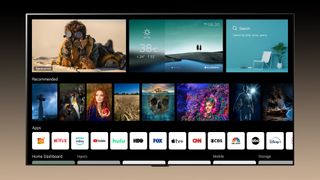
If you buy a new TV today, chances are it'll be a smart TV. This means it connects to the internet without an extra set-top box or streaming device, and allows you to access all your favorite apps, catch-up services, and streaming platforms.
However, in the same way that phones run on Android and others run on iOS, there are different operating systems built into many of the best smart TVs. So which one do you need, WebOS vs Tizen vs Roku or any of the other smart platforms out there?
Although many of these smart TV platforms have similar features, they can vary a huge amount in how the interface looks, which apps are supported and generally how intuitive everything is to navigate.
Even big services, like Disney Plus, or Freeview Play (for you UK readers), can be missing from certain platforms, so it's important to know what you're getting in for with your new TV purchase.
LG's webOS and Samsung's Tizen are often considered to be the best smart platforms – they're fast and fully stocked with the latest apps – though there's still plenty of reason to give other operating systems a look in.
Read our guide to the best streaming service to figure out which you need to look out for when you're choosing the best smart TV platform. Or, if you want smart features on an older TV, check out our guide to the best streaming devices.
Each platform has its pros and cons, which is why we've put together this guide to help you navigate the smart platforms out there, and decide which is the best for you.
Best smart TV platform of 2025 in full:
Why you can trust TechRadar
1. WebOS (LG)
Specifications
Reasons to buy
Reasons to avoid
LG rewrote the rulebook for smart platforms with its webOS, starting the trend for minimal, simplified user interfaces back in 2014. These days, it's still an exceptional smart platform that truly leads the pack.
In recent years, webOS has seen some major overhauls with the sixth iteration of the interface replacing its traditional overlay of apps for a full-screen view that's more spaced-out. Boasting an updated home screen which has been overhauled to be more intuitive, webOS 6.0 aims to provide faster access to your most used apps, while also allowing for content recommendations based on your viewing history. Now webOS 22 is rolling out on newer models, too.
LG also leads the way when it comes to voice recognition, with most sets supporting LG’s own ThinQ AI platform, Amazon Alexa and Google Assistant. Support for all these is built in, too, which means there’s no need for an external listening device.
App support is also surprisingly good: Netflix streams in 4K with both HDR and Dolby Vision, as well as Dolby Atmos audio when available. There's also Amazon with UHD HDR and YouTube in 4K, with Disney Plus naturally in the mix too. Other options include Now TV, Sky Store, Wuaki.TV, plus all the main channel catch-up services.
Overall, if you like clean, easily-navigable smart TV platforms, webOS is a great pick.
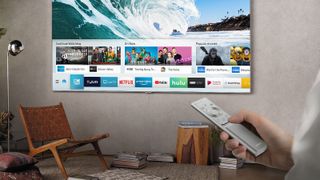
2. Tizen (Samsung)
Specifications
Reasons to buy
Reasons to avoid
Samsung is another brand keen to keep things simple – its Tizen OS clearly owes much to LG's webOS interface, in so much as it consists of icons, apps and shortcuts all accessible via icons held a horizontal strip across the bottom of the screen. A dynamically changing ‘Recent’ box in the far-left corner cycles between recently used apps and TV channels.
But it’s not overly intelligent as it stands right now, but that could change in the future when Samsung integrates its TV AI into Tizen.
For now, we like the fact that on-screen icons can be changed: a sense of identity is welcome when it comes to some AV inputs and key apps you use everyday. The OS cuts down on clutter, although this sometimes works against navigation – there are plenty of occasions when it's necessary to go hunting for a specific app. Thankfully that's made easier by a Smart Hub multimedia page that divvies up content from apps and from your own USB sticks/home network.
You'll find Tizen on all QLED TVs, and most Samsung 4K TVs. Higher-end models will get Bixby built-in too. But all Samsung sets come with Samsung SmartThings – which allows your TV to act as the center of your connected home.
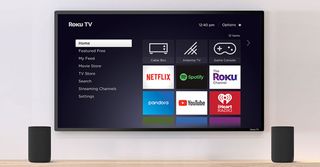
3. Roku TV
Specifications
Reasons to buy
Reasons to avoid
Announced back in 2014 for TCL TVs, Roku TV has found support with low-cost US TV suppliers. Today, you can find Roku TV on quite a few Haier, Hisense, Insignia, Sharp and TCL TV models – as well as a dedicated Hisense Roku TV model in the UK.
As a platform, Roku TV borrows the interface and feature set from the company's popular media streamers, like the Roku Streaming Stick.
What that means is that you'll find a universal search function able to scan over 30 different apps like Netflix, Google Play TV and Movies, Amazon, VUDU and more to find you the lowest price on the TV show or movie you want to watch, as well as around 4,500 channels of content to watch.
Once you get a Roku TV up and running, you’ll find an egalitarian operating system that handily retains its top spot as the best second-division operating system year after year. It’s intuitive to use, if a bit boring, and its lack of ties to a particular streaming platform allow it to point you to all the places content can be found without bias.
That last bit is important, especially if you’ve ever used an Apple TV or Amazon Fire TV, both of which would much rather have you stream from their ancillary streaming services over any of the third-party ones. Because Roku doesn’t have ties to a major streaming service – other than a vague deal to include FandangoNow on the home screen of the OS – it doesn’t push you any direction you don’t want to go and happily supports everything from Netflix, Hulu, Sling TV and Amazon, to lesser-known channels like Pluto.tv, tubi, Crackle and others.
Add to that some neat features like a dedicated app that helps you keep track of upcoming movies and TV shows via the My Feed section, a free TV streaming service built into the platform, and a private listening mode (via headphones that plug into the remote) when you want to watch TV without disturbing the whole house.
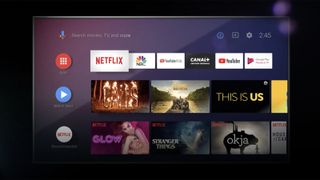
4. Android TV
Specifications
Reasons to buy
Reasons to avoid
Android TV is the nearest thing to a standardized operating system there is, but there are still variations between brand executions. Supporters of Android TV are Philips (via maker TP Vision) and, in the US, Sharp and Hisense. It’s also available on the Nvidia Shield streaming device.
Sony, however, has the most comprehensive Google solution. For UK viewers, it has rather cleverly layered a YouView program guide platform on top, deftly addressing one of Android TV’s big weaknesses – catch-up TV provision. This YouView app ensures that all the main catch-up services are provided, and accessible via a roll-back 7-day EPG.
While other TV platforms make a virtue of their minimalism, Android stacks the screen with various layers of content: there’s also a row of specific Sony selected content, followed by apps for Netflix, Amazon Video, links to the Google Play Store, Google Play Music, Google Play Movies and TV, YouTube and so on. You will get Disney Plus, but Apple TV Plus still isn't included on Sony TVs.
Owners of Android phones/tablets can use their device to control Android TVs via Sony’s TV SideView app, and Google Assistant continues to get more and more useful with its own Android TV integration. Android TV devices also have Chromecast built-in, which simplifies streaming from mobile Android devices (iOS users can download the AirBuddy app to Google Cast). Controllers from Logitech and Razer also promise gaming without needing a console.
The latest Android version 9.0 (Pie) also features a few Sony-specific improvements. Highlighting an option in the Settings menus, for instance, now brings up a cool ‘exploded’ explanation of what that feature does. There are also new voice control onscreen ‘tips’, and enhanced external device detection and information.
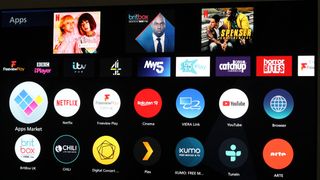
5. MyHomeScreen (Panasonic)
Specifications
Reasons to buy
Reasons to avoid
For UK users, Panasonic’s My Home Screen smart platform is decidedly simple compared to much of the competition – meaning it isn't as fleshed out as the likes of webOS or Tizen, but does offer a relatively unobtrusive interface for those simply wanting to get on with watching some TV.
When you press the Home button on the remote, you get a choice of three options: Live TV, Apps, and Devices. This simplicity is the platform’s greatest strength, making it easy to navigate and find things by helpfully storing all the apps in single location; you can also pin your favorite apps to the home page for quicker access.
You'll find this latest iteration on all new Panasonic TVs, though it will run fastest – and display its apps and content in the best light.
Since the smart platform is relatively simple, it doesn’t require a vast amount of processing power to operate, which makes it responsive, robust, and free from crashes. My Home Screen isn’t fragmented like some platforms, nor does it bombard you with recommendations – it simply delivers all the streaming and catch-up services you need.
Thanks to Freeview Play, a comprehensive list of catch-up services are included, covering BBC iPlayer, ITVhub, All4, My5, BBC News & Sport and UK Play. The iPlayer app supports 4K and HLG (Hybrid Log-Gamma – the broadcast version of HDR), both of which the BBC trialled during the World Cup.
While the app support is generally good, you are missing out on both NOW TV and Disney Plus – the latter of which feels especially odd, as the biggest TV streaming service to launch in the past year.
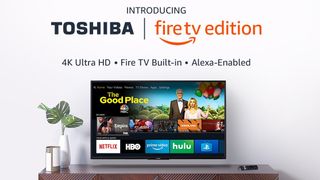
6. Amazon Fire TV
Specifications
Reasons to buy
Reasons to avoid
We can't talk about the best smart platforms without mentioning Amazon Fire TV – the proprietary OS used in the Amazon Fire TV streaming stick, and an increasing number of televisions too.
You'll largely find it on streaming sticks, like the Fire TV Stick Lite or Fire TV Stick 4K, where it offers a comprehensive catalogue of apps and services – even if it's quite heavily populated with Amazon Prime Video content and channels – as well as a capable voice remote, with volume and AV controls varying between each model. Alexa is one of the (if not the) best voice assistants out there, while the Fire TV platform as a whole is fast and versatile.
It's a different matter with TVs, as the Fire TV platform tends to be licensed to quite cheap and low-spec displays from Toshiba, Insignia, and JVC. Some of these TVs are OK, but many aren't, undermining the strengths of the operating system they make use of. You can read more about this in our Should I buy a Toshiba Fire TV? guide.
If you're interested in the speed and versatility of Amazon's smart TV platform, we recommend buying an Amazon Fire TV Stick 4K instead – which you can plug into any dumb or smart television anyway if you aren't happy with your current interface.
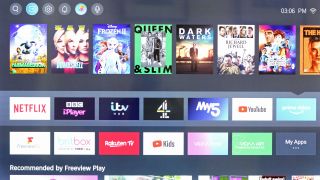
7. Vidaa U (Hisense)
Specifications
Reasons to buy
Reasons to avoid
Hisense makes use of quite a few different smart platforms – Roku TV and Android TV among them – but a number of mid-range Hisense sets instead use an in-house operating system called Vidaa U.
Why is it called that? We're never quite sure. But Vidaa U has been a consistently stable smart platform throughout our various tests. It's not the flashiest OS, but is well laid-out, and largely copes well with the demands of a modern smart TV – though there is the occasionally frustrating quirk, such as the O8B OLED's persistent (and unwelcome) screensaver.
It doesn't boast as many apps and services as some other platforms, but you will find the likes of Netflix, Amazon Prime Video, Rakuten, YouTube, and Disney Plus, complete with 4K and HDR playback where a platform offers them. UK viewers will get FreeView Play for catch-up streaming from UK broadcasters too.
You might see Netflix given pride of place, too – likely in a lucrative deal with Hisense – it's impossible to move or delete the app from your home screen on Vidaa U sets in the UK.
We'll be keeping an eye out to see how Vidaa U changes and improves – hopefully by removing or fleshing out some unnecessary features, like the 'Vidaa Free' that packages together YouTube videos rather than dedicated free content.
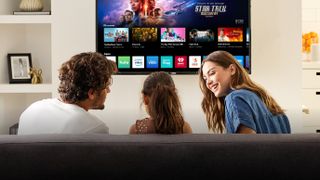
8. SmartCast (Vizio)
Specifications
Reasons to buy
Reasons to avoid
SmartCast, on paper, is a great idea. It's all the fun extras of the Android TV platform – including the ability to Cast content to your screen – with a more logical layout.
When you turn on a SmartCast TV be prepared to see three rows – one featured row that has huge marquee images to point you to specific shows or movies; one row for recommended content and one row for all your apps.
If you want to drill down into specific content categories or settings, you can move to one of the other tabs (there's a tab for movies, TV shows, Support and Extras) or go to the top right of the screen to perform a search.
Unfortunately, while SmartCast provides a lot of versatility in what you can stream – it's a lot better than it’s been in past years thanks to the addition of Apple TV Plus, Disney Plus and Peacock – it's also one of the slower smart platforms and can misbehave on occasion.
That said, we can't knock the Vizio OLED – it's one of this year's best TVs, despite the middling nature of its OS.
Get daily insight, inspiration and deals in your inbox
Sign up for breaking news, reviews, opinion, top tech deals, and more.
Nick Pino is Managing Editor, TV and AV for TechRadar's sister site, Tom's Guide. Previously, he was the Senior Editor of Home Entertainment at TechRadar, covering TVs, headphones, speakers, video games, VR and streaming devices. He's also written for GamesRadar+, Official Xbox Magazine, PC Gamer and other outlets over the last decade, and he has a degree in computer science he's not using if anyone wants it.
